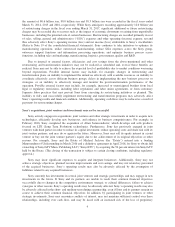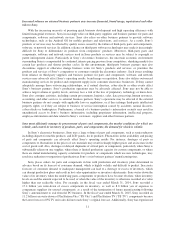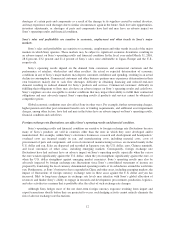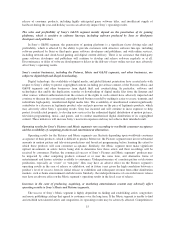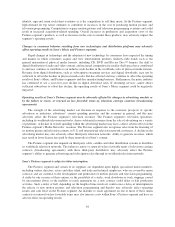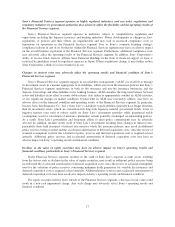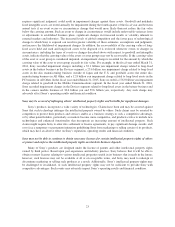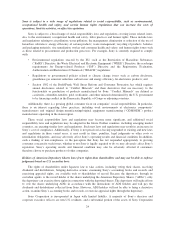Sony 2015 Annual Report Download - page 18
Download and view the complete annual report
Please find page 18 of the 2015 Sony annual report below. You can navigate through the pages in the report by either clicking on the pages listed below, or by using the keyword search tool below to find specific information within the annual report.The investment portfolio within Sony’s Financial Services segment exposes Sony to a number of additional
risks other than the risks related to declines in the value of equity securities and changes in interest rates.
In the Financial Services segment, generating stable investment income is important to its operations, and
the Financial Services segment’s investments are concentrated in long-term Japanese national government bonds,
although it also has investments in a variety of asset classes, including shorter-term Japanese national
government bonds, Japanese local government and corporate bonds, foreign government and corporate bonds,
Japanese stocks, loans and real estate. In addition to risks related to changes in interest rates and the value of
equity securities, the Financial Services segment’s investment portfolio is exposed to a variety of other risks,
including foreign exchange risk, credit risk and real estate investment risk, any or all of which may have an
adverse effect on the operating results and financial condition of the Financial Services segment. For example,
mortgage loans account for 92.0 percent of the total loan balance, or 57.7 percent of the total assets of Sony Bank
Inc. (“Sony Bank”), as of March 31, 2016. An increase in non-performing loans or a decline in the prices of real
estate, the collateral for these mortgage loans provided by Sony Bank, may result in an increase in the allowance
for doubtful accounts.
Differences between actual and assumed policy benefits and claims may require Sony’s Financial Services
segment to increase policy reserves in the future.
The life insurance and non-life insurance businesses of the Financial Services segment establish policy
reserves for future benefits and claims based on the Insurance Business Act of Japan and related regulations.
These reserves are calculated based on many assumptions and estimates, including the frequency and timing of
the event covered by the policy, the amount of benefits or claims to be paid and the investment returns on the
assets these businesses purchase with the premiums received. These assumptions and estimates are inherently
uncertain, and the Financial Services segment cannot determine with precision the ultimate amounts that it will
be required to pay for, or the timing of payment of, actual benefits and claims, or whether the assets supporting
the policy liabilities will grow at the level assumed prior to the payment of benefits or claims. The frequency and
timing of an event covered by a policy and the amount of benefits or claims to be paid are subject to a number of
risks and uncertainties, many of which are outside of its control, including:
• changes in trends underlying its assumptions and estimates, such as mortality and morbidity rates;
• the availability of sufficient reliable data and its ability to correctly analyze the data;
• the selection and application of appropriate pricing and rating techniques; and
• changes in legal standards, claim settlement practices and medical care expenses.
If the actual experience of the insurance businesses becomes significantly less favorable than their
assumptions or estimates, their policy reserves may be inadequate. Any changes in regulatory guidelines or
standards with respect to the required level of policy reserves may also require that the insurance businesses
establish policy reserves based on more stringent assumptions, estimates or actuarial calculations. Such events
may result in a need to increase provisions for policy reserves, which may have an adverse effect on the
operating results and financial condition of the Financial Services segment.
Furthermore, if actual insurance claims are higher than the estimated provision for policy reserves due to the
occurrence of catastrophic events such as earthquakes or pandemic diseases in Japan, or if strategies for hedging
minimum guarantees in individual variable annuities are ineffective, then the operating results and financial
condition of the Financial Services segment may be adversely impacted.
Sony’s physical facilities and information systems are subject to damage as a result of catastrophic disasters,
outages, malfeasance or similar events. Such an unexpected catastrophic event may also lead to supply chain
and production disruptions as well as lower demand from commercial customers, resulting in an adverse
impact on Sony’s operating results.
Sony’s headquarters and many of Sony’s most advanced device manufacturing facilities, including those for
semiconductors, are located in Japan, where the risk of earthquakes is relatively high compared to other parts of
18



